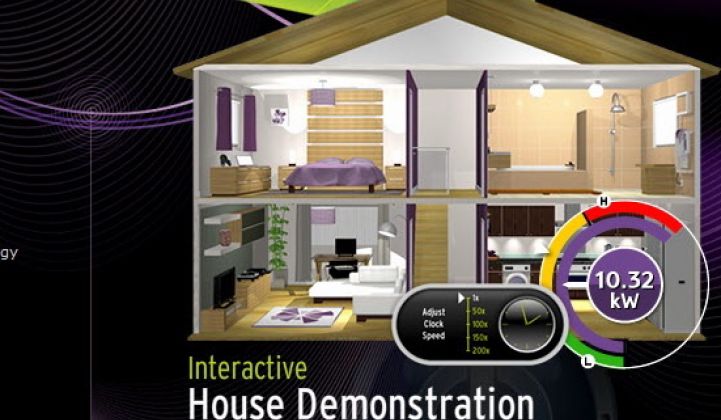Can your smart meter figure out exactly how much power your household appliances are using, without installing expensive networks or sensors in the home to make it happen? U.K.-based startup Navetas says its “energy disaggregation” technology can do just that, and on Wednesday it landed a £5 million ($7.9 million) investment from big meter maker Sensus, along with an exclusive licensing agreement to try it out in the United States.
The University of Oxford spinout is taking a unique approach to a complex challenge: to identify and track different household power loads, such as dishwashers, refrigerators, washer/dryers, TVs, computers, water heaters, lights, and the like, by sampling electric voltage and current data from a single point. Today's smart meters only measure total power usage, leaving people to guess what's causing spikes and sags in that number over time.
Navetas, which has previously raised £7 million ($11.1 million) from Swarraton Partners, Naxos Capital and the University of Oxford, says its technology can “learn” a typical home’s mix of energy loads over the course of a week or two, depending on how often the homeowner happens to use different appliances. That information can then be presented to homeowners via in-home displays or web and mobile platforms, as well as going back to the utility to help it understand how its customers are using their energy.
That, in turn, could be a very attractive proposition for utilities that want to give customers the ability to see power use across different household appliances, but don't want to spend money on installing the gear to monitor every single one of them.
It’s a similar concept to the “one-plug” home load disaggregation technology being developed by startup PowerMap and consumer electronics giant Belkin, via its acquisition of Zensi in 2010. Intel Labs has also played with the concept, though it says it has no plans to commercialize the technology.
But Navetas CEO Chris Saunders said his company’s technology differs from those others in certain key ways, most notably in its “unique” rate of sampling power data. He also noted that Navetas does not rely on matching appliances to pre-existing profiles or injecting noise onto the power circuits, as some other technologies do.
Instead, “we go into a process where we identify the core elements of an appliance -- for instance, we can identify heating loads, induction motor loads, consumer electronics loads and things like that,” Saunders said in an interview. “We then look at associations between all of those within the home to piece together what is occurring, and to identify discrete appliances.”
Navetas is already piloting its technology with three U.K. utilities as part of that country’s push to deploy home energy management systems to link up with the 53 million smart meters it’s planning to deploy over the coming decade. It’s one of several U.K.-based home energy startups, including AlertMe and Onzo, targeting the market.
Saunders said the startup is also working on other home appliance pilots in Europe, as well as a pilot in Asia to disaggregate commercial and industrial loads, though he wouldn’t name any partners on those efforts, citing nondisclosure agreements.
In the United States, Sensus will be the exclusive provider of Navetas’ technology, and plans to incorporate the technology in its upcoming line of smart meters, said Matt Zafuto, vice president of corporate strategy and business development.
From there, Sensus could link that home appliance disaggregation data to customers via ZigBee-enabled meter-to-home channels, or carry it back to the utility for presentation via web portals or other means, he said. While he didn’t name any utilities who’ve signed on as of yet, Sensus plans to make it widely available to its customer base, he added.
Utilities may see a lot of value in giving their customers the ability to see how individual appliances and systems use energy differently, but they’ve been loath to actually go past the meter into people’s homes to install technology to do it, Zafuto noted. Putting Navetas’ no-touch disaggregation capabilities in each meter could make that process a lot less complicated and costly, he said.
That, in turn, could give utilities the ability to do things like show customers just how much energy they’re saving through air conditioner or water heater direct-load-control demand response programs, he said -- something that might make those programs more popular than they are today.
On the utility side, “There are a number of sophisticated approaches that utilities can use that data for, in terms of justifying rates or rebate programs,” he said. “They’ll have a lot more knowledge of what’s going on in their distribution network.”
Navetas’ algorithms can be applied to differentiate natural gas and water uses within homes as well, and Sensus, which supplies all three types of meters, is working on those applications as well, he added.
Also, because Sensus uses licensed 700-megahertz spectrum to link its meters to towers in a more real-time way, it could be possible to carry all that data back from meters to utility back-office systems and thence to customer web portals in close to real time, he noted -- something that wireless mesh smart meters, which only transmit every hour or so, would have trouble doing.
The two companies are also looking at potential partnerships in the U.K. smart grid, said Zafuto, where Sensus is part of one of several consortia seeking a piece of the government’s $7.5 billion open bid for communications contracts to connect the smart meters to come.



